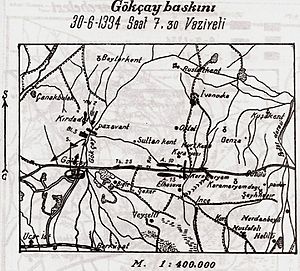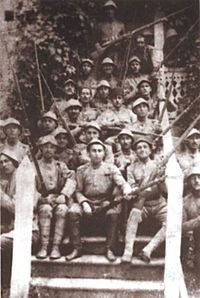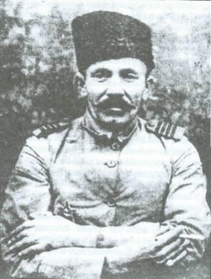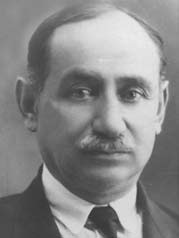Battle of Goychay facts for kids
Quick facts for kids Battle of Goychay |
|||||||||
|---|---|---|---|---|---|---|---|---|---|
| Part of the Armenian-Azerbaijani War during the Caucasus Campaign of World War I and Southern Front of the Russian Civil War | |||||||||
 Battle plan written in Turkish. |
|||||||||
|
|||||||||
| Belligerents | |||||||||
| Central Powers: |
Bolsheviks: Entente Powers: White movement: |
||||||||
| Commanders and leaders | |||||||||
| Strength | |||||||||
| Casualties and losses | |||||||||
| Unknown | Unknown | ||||||||
The Battle of Goychay was a series of important fights that happened from June 27 to July 1, 1918. It was a clash between the Ottoman and Azerbaijani forces against the Soviet 11th Army and Armenian groups. Even though the Ottoman-Azerbaijani forces were greatly outnumbered, they won the battle. This victory stopped the Armenian-Soviet forces from reaching Ganja, which was a key city. After the battle, the Ottoman-Azerbaijani forces took control of the area from Goychay to Shamakhi. This also ended Armenian-Soviet control in that region.
Contents
Why the Battle Happened
The Baku Commune, led by Stepan Shaumian, decided to start a military operation. Their goal was to stop the Ottoman Army from getting stronger in Ganja. On June 4, 1918, Grigory Korganov, a military leader from Baku, ordered the Red Army to act. He told the Armenian-Bolshevik-Russian forces to capture the area up to Yevlakh and take control of the Yevlakh bridge.
On June 6, Armenian and Russian-Bolshevik troops left Baku for Kazi-Magomed (now Hajigabul). They took over Kazi-Magomed and destroyed the villages around it.
Moving Towards Ganja
The Red Army forces gathered at Kazi-Magomed Station. On June 10, they started moving towards Ganja, which was the capital of the Azerbaijan Democratic Republic at the time. A small group of Georgian and Azerbaijani fighters tried to stop the Red Army. However, the Red Army forces managed to capture Syghyr Station on June 10.
Shaumian learned that the Ottoman military had not yet fully arrived in Ganja. He wanted to use this chance to his advantage. He was very happy about taking Syghyr Station. He even sent a message to Vladimir Lenin, saying, "Our military forces are moving forward."
Taking Kyurdamir
One part of the Red Army moved west along the railway towards Myusyuslyu Station. Another part went through Hajigabul and reached Kyurdamir. The Red Army forces attacked Kyurdamir. The local Azerbaijani fighters tried to defend the city but were not successful. The Red Army took control of both the station and the city.
The capture of Kyurdamir by the Bolshevik-Dashnak forces worried the Ottoman-Azerbaijani forces in Ganja. It made it harder for the Islamic Army of the Caucasus to advance towards Baku.
Battles in Shamakhi, Aghsu, and Ismailly
A third group of the Red Army moved from the north of Baku. They went along the highway towards the north-west, entering Maraza and Shamakhi. The Armenian forces, led by Bolsheviks, attacked the village of Bijo. A fight broke out between the villagers and 400 Armenian troops. The villagers won this battle.
Because of this unexpected loss, the Bolsheviks sent a larger force to Bijo. The villagers had to leave their homes and move to Aghsu and then to Goychay. After burning Bijo, the Armenian-Bolshevik forces moved to Aghsu, then to the villages of Garamaryam and Bygyr.
On June 16, the 11th Army's forces attacked Azerbaijani, Dagestani, and Georgian fighters in the region. After a seven-hour battle, the local forces had to retreat to Goychay. The 11th Army gained more support from Armenian and Russian villages in the area.
Who Fought: Comparing the Forces
Some historians from the Soviet era said that the Ottoman Army had more soldiers than the Bolsheviks. However, other historians, like Mustafa Görüryılmaz, say the opposite was true. He wrote that "at the start of the battle, the Turkish military force in Azerbaijan was less than five thousand. Meanwhile, the Red Army had over 30 thousand soldiers, including Armenian groups."
The number of Azerbaijani soldiers who fought is not fully known, but it was likely less than 5,000. The first Azerbaijani military group, the Azerbaijani Special Corps, was formed on June 26. It had fewer than 5,000 men. Many volunteers from nearby towns also joined the Ottoman-Azerbaijani forces.
The Red Army forces were not from Azerbaijan. Many of them were former soldiers from the Imperial Russian Army who joined the Bolsheviks after the October Revolution. Many of the Armenian Dashnak forces were from Western Armenia or the First Republic of Armenia.
Stepan Shaumian sent a message to Lenin saying that the "Bolshevik-Dashnak forces showed great courage at the Battle of Goychay." But he also said their commanders acted "cowardly." He believed that anti-communist messages from the British Secret Intelligence Service also played a role in their defeat.
A group of Cossacks from Persia, led by Lazar Bicherakhov, also joined the fight. They had about one thousand men. Even though they were part of the White movement, they agreed to help the Baku Commissars fight against the Ottoman-Azerbaijani forces. Bicherakhov's group arrived by sea and was sent to the Kyurdamir front on July 7. They suffered many losses.
Bicherakhov was put in charge of the combined Bolshevik-Dashnak-Cossack forces. However, he did not always follow orders, which caused confusion. On July 30, Bicherakhov left the battle and went to Dagestan with his group. He said he "refused the command of the army of deserters and cowards." His unit lost over 100 soldiers during the fighting.
First Attacks
Veysalli and Garamaryam Clashes
The main base for the Islamic Army of the Caucasus was in Ganja. Their leaders realized there was nothing stopping the enemy from reaching Ganja by railway. Nuru Pasha believed the biggest threat would come from the Red Army forces near Goychay. The fights in the Goychay region were very important. They led to the Red Army leaving Azerbaijan, which helped Azerbaijan become independent.
Not all soldiers of the 5th Caucasian Infantry Division had reached Ganja yet. The 10th Caucasian Infantry Regiment arrived in Goychay on June 15. Some forces were sent to the Myusyuslyu and Kyurdamir fronts. The 10th Caucasian Infantry Regiment, led by Topal Osman, went to the Garamaryam front. After a few days of fighting, the Ottoman forces defeated the Armenian troops, making them retreat.
Nazım Bey, a chief of staff, ordered Topal Osman to gather information about the Armenian-Soviet forces. On June 17, the 28th Battalion attacked the Armenian-Bolshevik forces west of Garamaryam. However, they walked into a Soviet ambush. After a tough fight, the Ottoman forces had to retreat to the village of Veysalli.
Seeing the danger, Topal Osman moved his 30th and 28th Battalions to protect the 28th Battalion. But Bolshevik forces attacked them in an area with steep valleys and hills. The 29th Battalion, attacked from both sides, managed to move to Veysalli after a very difficult fight.
During the day, neither side could win in the hot weather. When night came, they stopped fighting and went back to their starting positions. This first major battle for the Ottoman Islamic Army of the Caucasus near Garamaryam was a failure. The Bolsheviks, especially their 3rd division and its leader Hamazasp Srvandztyan, felt much more confident. They became stronger in Garamaryam and took important positions, allowing them to attack Goychay.
The Ottoman-Azerbaijani army lost about 200 soldiers in this first battle near Garamaryam, and 156 were wounded. The Armenian-Soviet forces captured some cannons and ammunition from them.
Myusyuslyu Attack
The commander of the 10th Caucasian Infantry Regiment told Topal Osman to distract the Bolsheviks near Garamaryam. This was to stop them from attacking Goychay. Topal Osman did not expect more forces to arrive from Ganja.
The Ottoman-Azerbaijani troops in Myusyuslyu, led by Nazım Bey, decided to launch an attack on the Red Army forces without permission from their commander, Nuru Pasha. They did this to find out how strong the enemy was and where they were located. At the time of this attack, the Ottoman-Azerbaijani reserve forces had not even been used.
Second Attack

After the first defeat, Nuru Pasha, along with Azerbaijani leader Ali-Agha Shikhlinski and others, arrived at Myusyuslyu Station on June 18. They met with their staff and discussed the war. Then, Nuru Pasha went to Goychay to meet with Lieutenant Colonel Topal Osman and talk about the situation.
Reports said that Bolshevik Red Army forces had burned more than 50 villages between Baku and Garamaryam. Many Azerbaijanis living in those villages were killed. Those who escaped found safety in Goychay and nearby areas. The number of people who fled from Shamakhi, Ismailly, and other places was over 400,000.
The Red Army forces were able to get Armenians and Russians from nearby villages to join them, forming an army of 30,000 men.
Nuru Pasha had hoped that thousands of Azerbaijanis would join the Islamic Army of the Caucasus, but he was disappointed. Only a few thousand local fighters joined, which was not the help he wanted. He went to Goychay and spoke to the public, expressing his disappointment. He explained that the Ottoman Empire sent soldiers from their homeland to help their "Azerbaijani brothers" and other Turks. He stressed that everyone should join the army willingly.
He also said, "Many of our soldiers fighting in this fierce warmth died of dehydration. Since you're not joining the army, at least you have to help by carrying food and water for these soldiers."
Nuru Pasha met with Azerbaijani thinkers and elders in the Goychay region. He managed to get their support, which led to more people joining the army. Many teenagers and adults from Goychay, Aghdash, Yevlakh, and Barda came to the front line for military training.
Nuru Pasha sent two important reports to Istanbul. In these reports, he said that the Bolsheviks were getting stronger in the Caucasus. He also noted that the Azerbaijanis were not forming a large enough force for the army. He concluded that the 5th Caucasian Infantry Division could not operate well in the region alone.
Nuru Pasha wrote, "We expected at least 30 thousand Turks [Azeris] here to join the army. But only 37 have joined. To solve the Baku oil problem, another division needs to arrive. Muslims [Azeris] here talk a lot but do little work. They are not very helpful. To free Azerbaijan and Baku, the Ottoman State needs to show its strength. The 5th Division needs urgent support. Otherwise, our situation will not be good."
The front line between the Ottoman-Azerbaijani and Red Army forces was stuck. Nuru Pasha feared they might lose. He knew that the Allies would attack the Ottomans more, meaning no more soldiers could be sent to the Caucasus. He sent a letter to Mürsel Bey, a commander. In the letter, Nuru Pasha said troops would move to the lines on June 23–24, and an attack was planned for June 27–28.
During these preparations, Bolshevik spies gave important information to the Red Army. The Bolsheviks launched an attack on June 27 with three battalions. Some moved north and attacked the 10th Caucasian Infantry Regiment from behind. From the south, they made small attacks to lower Ottoman spirits. Meanwhile, new soldiers arrived and joined the 10th Caucasian Infantry Regiment. After fierce fighting, the Ottoman forces successfully defended against the Bolshevik attack.
The 10th Caucasian Infantry Regiment counter-attacked the Red Army and pushed them back about 3 kilometers (1.9 miles). On June 29, the 5th Caucasus Infantry Division prepared for its first combined operation in Azerbaijan. The attack would involve the 10th and 13th Caucasian Infantry Regiments, while the 2nd Cavalry Regiment would attack the Bolsheviks from their left side. At this point, the Ottomans had very little water, food, and ammunition.
Because of the very hot weather, neither side could launch a full attack. Ottoman water supplies came from Goychay. Due to supply problems, both sides often fought with bayonets. By the end of the day, Ottoman-Azerbaijani forces controlled the western parts of Garamaryam and some of the northeastern part. The western parts of Garamaryam were flat. The Bolsheviks' escape routes were greatly reduced because of the high hills to the east. The Bolshevik forces decided to leave Garamaryam as quickly as possible.
On June 30, the Red Army launched a surprise attack on the 10th Caucasian Infantry Regiment, but it failed. During the battle for Garamaryam, Azerbaijani volunteer cavalry forces were led by Habib Bey Salimov.
Red Army forces launched a night attack on the 5th Caucasus Infantry Division in Goychay from their left side. They had help from local Armenian and Russian villages. The attacking force had about a thousand troops, two cannons, and two machine guns. Bolshevik forces, led by an Armenian named Emirov, attacked the villages of Pazavand and Kyrdadut. The people of Goychay fled to Ujar. There were no regular soldiers in the city.
That night, a new volunteer cavalry division, led by General-Major Ahmad Hamdi Gara Agha Zadeh, arrived in Ganja. They immediately marched to Goychay. The head of the General Staff told the 25th Infantry Battalion about the attack and ordered them to help Goychay. He also called for the commander of the Aghdash region, General Ali İhsan Sâbis, to help. The Azerbaijani cavalry forces tried to hold off the Bolsheviks but were defeated by 7:00 AM.
The 25th Infantry Battalion and some local fighters from the Garamaryam front reached Goychay. Nuru Pasha saw that Goychay was about to be captured and that his forces might be surrounded. He sent some troops from Garamaryam and Aghdash to help defend Goychay. The 9th Caucasian Regiment, stationed in Poylu under Cemil Cahit Toydemir, and local fighters from Shaki and Zagatala, led by Yusif bey Tahirov, were ordered to move to Goychay.
With artillery and fire support, the 25th Infantry Battalion and local fighters successfully surrounded the Bolshevik forces. The Bolsheviks suffered many losses. The remaining defeated Bolshevik forces fled to Garamaryam. However, they were then attacked by the 13th Caucasian Infantry. After that, these Bolshevik forces were attacked again by the 5th Caucasian Infantry Division, which caused them more losses. The Bolshevik forces in Garamaryam were attacked once more. This forced them to flee east towards Baku.
What Happened Next
Many weapons and ammunition were taken from the Red Army. Small Armenian and Russian uprisings in Aghdash, Goychay, and Ismayilli were stopped. The Ottoman-Azerbaijani forces also took their weapons. Most of the wounded Ottoman soldiers were sent to Ganja. Fallen Turkish soldiers were buried in Khanlar and Goranboy.
Enver Pasha was busy looking at battle reports. The Germans did not want Ottoman forces to enter Baku. Enver Pasha was trying to delay them. Here is part of an order Enver Pasha sent on June 26:
Moving to Baku will create a threat of Bolsheviks destroying the oil reserves in Baku. We must avoid this at all costs for the good of the military. For this reason, I order that the 5th Caucasian Infantry Division cannot attack Baku without my approval. Please, do not send more forces to Nuru Pasha without my approval. Send back any extra forces already sent to him. As I said before, Nuru Pasha will gather his forces and only stop the Bolshevik advance.
—Enver Pasha
Enver Pasha also sent a secret order to Nuru Pasha, his brother:
It is not smart to send you help. Your goal was not to move to Baku. I am repeating that you must gather your forces and stop the Bolshevik movement to Ganja.
—Enver Pasha
Enver Pasha secretly told his commanders that he was sending more soldiers and artillery to help Nuru Pasha. He was trying to convince the Germans that the Ottoman Army would not enter Baku. But he was also secretly ordering Nuru Pasha to capture the oil-rich city as quickly as possible. On July 2, Enver Pasha sent a personal letter to Mehmet Esat Bülkat, telling him not to talk about the secret orders with Otto von Feldmann.
Here is part of an order Enver Pasha sent to the commanders of the Eastern Army Group:
I am asking you to quickly strengthen Nuru Pasha's forces in Ganja with available soldiers, weapons, and ammunition. Do this before the situation gets worse with Feldmann's arrival. Inform Nuru Pasha with my personal and secret letters, and do not let Germans know about this secret way of communicating.
—Enver Pasha
Images for kids







